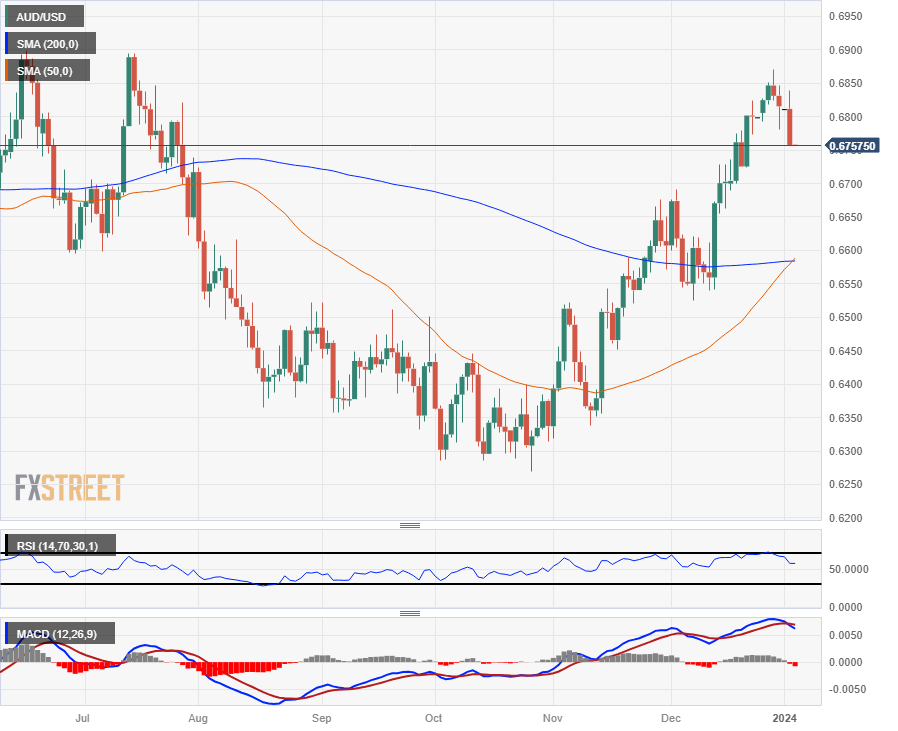- Phân tích
- Tin tức và các công cụ
- Tin tức thị trường
- AUD/USD declines into 0.6750 as Greenback lurches higher, China data beat bolsters Aussie
AUD/USD declines into 0.6750 as Greenback lurches higher, China data beat bolsters Aussie
- AUD/USD sheds eight-tenths of a percent on Tuesday.
- Safe-haven bids into the USD are on the rise, propping up US Dollar pairs.
- Despite Greenback gains, Aussie remains well-bid following China PMI upswing.
The AUD/USD fell on Tuesday, sliding 0.8% on the day to kick off the first official trading day of 2024 with broader markets tipping back into the US Dollar (USD), though Aussie (AUD) losses were limited by a better-than-expected print in China’s Caixin Manufacturing Purchasing Managers’ Index (PMI) in December.
Sky-high market bets of rate cuts from the Federal Reserve (Fed) are beginning to ease as investors walk back rate cut forecasts to 150 basis points through 2024, and hobbled economic data from the US is crimping investor sentiment as markets gear up for the year’s first Nonfarm Payrolls (NFP) print due on Friday.
China’s December Manufacturing PMI came in slightly above expectations, printing at 50.8 versus the forecast decline from 50.7 to 50.4, bolstering risk appetite in the Aisa market session and helping to keep the AUD bid against the majority of major currencies, though a softening of the US S&P Global Manufacturing PMI for the same period missed expectations, souring risk appetite and sending the US Dollar higher across the board.
Softer US data props up USD bids
The US Manufacturing PMI in December sunk to a four-month low of 47.9 versus the market forecast of a steady print of 48.2.
The market is gearing up for December’s US NFP print on Friday, which is forecast to decrease from 199K to 168K, but before that will be Thursday’s China Caixin Services PMI which last printed at 51.5, as well as US ADP Employment Change, which is expected to tick up slightly from 103K to 115K.
Wednesday also brings a heavy US-data focus, with the ISM Manufacturing PMI for December forecast to improve from 46.7 to 47.1, as well as the latest Fed Meeting Minutes, which investors will be pouring over to try and catch a glimpse of how far Fed policymakers are leaning towards beginning the next rate cut cycle.
AUD/USD Technical Levels
Tuesday’s AUD/USD decline has sent the pair tumbling below the 200-hour Simple Moving Average (SMA) for the first time since the pair’s strong upshot in mid-December, settling the AUD/USD into a two-week low near 0.6750.
The pair is down over 1.5% from last week’s peak at 0.6870, and the AUD/USD could be set for an extended backslide with technical indicators pinned into overbought territory, though a technical floor is pricing in from just south of the 0.6600 handle with the 50-day SMA confirming a bullish cross of the long-run 200-day SMA.
AUD/USD Hourly Chart

AUD/USD Daily Chart

AUD/USD Technical Levels
© 2000-2024. Bản quyền Teletrade.
Trang web này được quản lý bởi Teletrade D.J. LLC 2351 LLC 2022 (Euro House, Richmond Hill Road, Kingstown, VC0100, St. Vincent and the Grenadines).
Thông tin trên trang web không phải là cơ sở để đưa ra quyết định đầu tư và chỉ được cung cấp cho mục đích làm quen.
Giao dịch trên thị trường tài chính (đặc biệt là giao dịch sử dụng các công cụ biên) mở ra những cơ hội lớn và tạo điều kiện cho các nhà đầu tư sẵn sàng mạo hiểm để thu lợi nhuận, tuy nhiên nó mang trong mình nguy cơ rủi ro khá cao. Chính vì vậy trước khi tiến hành giao dịch cần phải xem xét mọi mặt vấn đề chấp nhận tiến hành giao dịch cụ thể xét theo quan điểm của nguồn lực tài chính sẵn có và mức độ am hiểu thị trường tài chính.
Sử dụng thông tin: sử dụng toàn bộ hay riêng biệt các dữ liệu trên trang web của công ty TeleTrade như một nguồn cung cấp thông tin nhất định. Việc sử dụng tư liệu từ trang web cần kèm theo liên kết đến trang teletrade.vn. Việc tự động thu thập số liệu cũng như thông tin từ trang web TeleTrade đều không được phép.
Xin vui lòng liên hệ với pr@teletrade.global nếu có câu hỏi.















